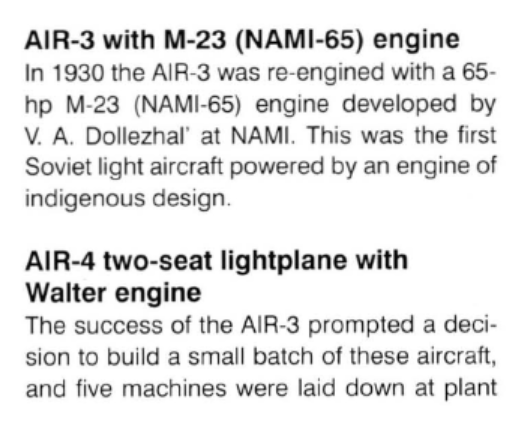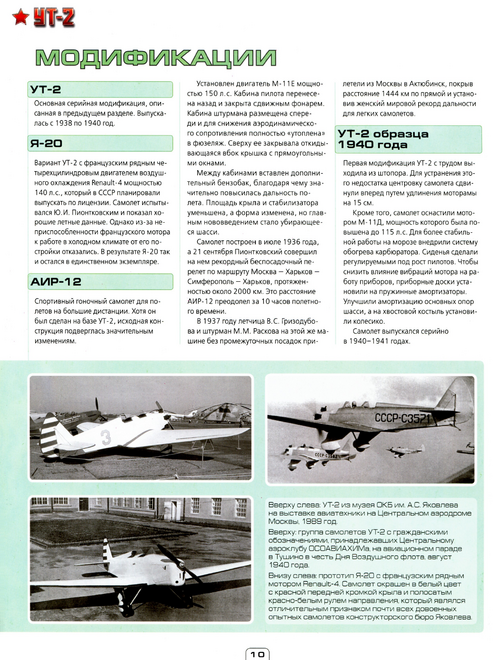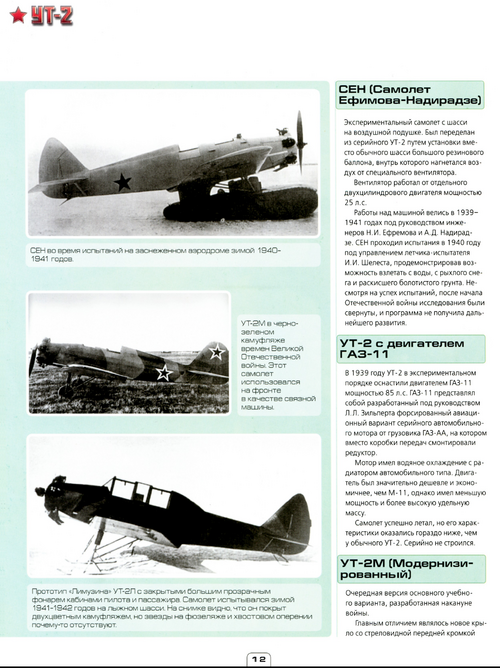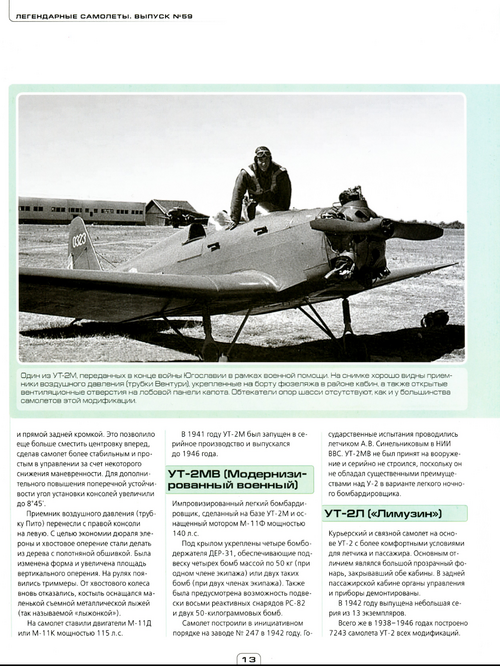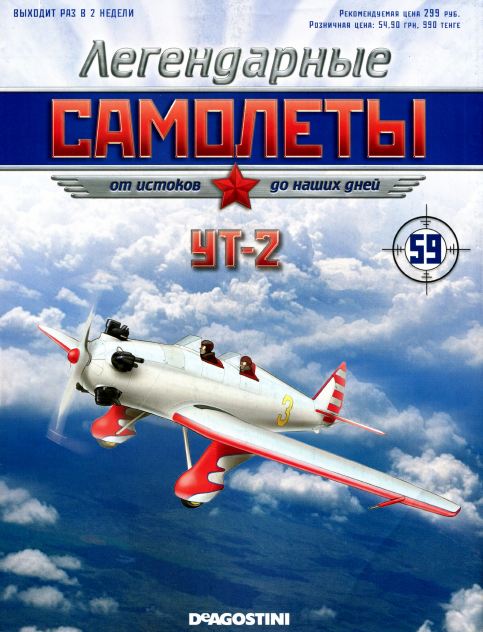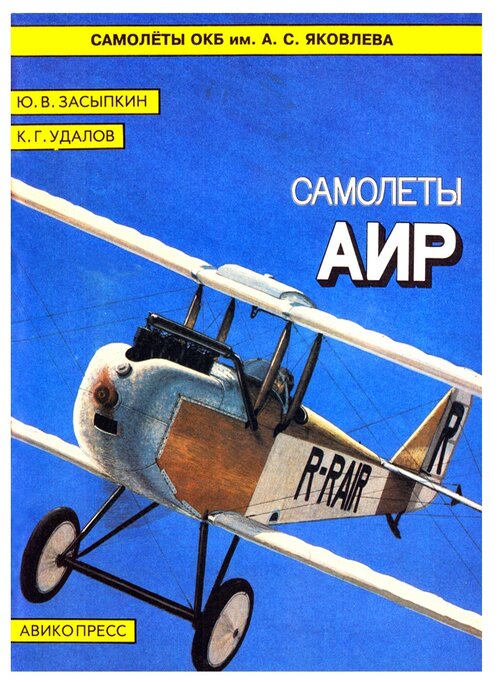You are using an out of date browser. It may not display this or other websites correctly.
You should upgrade or use an alternative browser.
You should upgrade or use an alternative browser.
Yakovlev aircraft
- Thread starter AM
- Start date
- Joined
- 25 July 2007
- Messages
- 4,261
- Reaction score
- 4,011
I'll have a go at the earliest series of Yakovlev designations ...
One of Alexander Sergeyevich Yakovlev's earliest involvements in aircraft design was with the Makaka (Macaque) - a biplane hang-glider with stub cockpit nacelle, boom rear fuselage, and wing-strut-mounted ailerons. Design and construction lead for that glider came from pilot and flight-engineer, Nikolai Anotchenko, with a 17-year-old A. S. Yakovlev assisting. So no Yakovlev designation was applied to the Makaka. [1]
Early Designation Systems for Yakovlev Aircraft Designs
The first designation system given to Yakovlev designs were in the AVF series. Standing for Akademiya Vozdushnogo Flota (Soviet Air Fleet Academy), AVF series designations were applied to all aircraft built at the Academy workshops. [2] The first glider entirely of A. S. Yakovlev's design was the tenth to be built at those Academy workshops and, thus, received the designation AVF-10. Yakovlev penned two other glider designs during his time at the Akademiya Vozdushnogo Flota, but one would remain unbuilt.
Following the Akademiya Vozdushnogo Flota, in 1927, A. S. Yakovlev attended the Voyenno-Vozdushnaya Akademiya (Air Force Academy). As a result, Yakovlev's first powered aircraft designs initially received 'VVA' designations. Again, these designations were numbered in an Academy sequence. [3] Yakovlev produced two designs - the VVA-3 and VVA-5 - but these were quickly redesignated in the following 'AIR' sequence.
One brief but mysterious (to me, at least) alternative designation system was the 1936 'LT' sequence. These were LT-1 - aka AIR-11 cabin touring monoplane - and LT-2 - aka AIR-16, a failed 4-seat derivative of the AIR-10. Alas, I have no idea what 'LT' stood for. (Perhaps 'Legkiy Turisticheskiy' or 'Legkiy Transportnyy'?)
The Yakovlev 'AIR' series of designations were named for renamed in honour of Alexei Ivanovich Rykov who, in 1928, was the Soviet Chairman of the Council of People's Commissars. At least 21 aircraft designs were numbered under the 'AIR' system but these were eclipsed by a new 'Ya' for Yakovlev sequence when Rykov was disgraced politically. [4]
The 'Ya' for Yakovlev sequence are often better-known by their military VVS designations (which will be mentioned under their appropriate 'Ya' numbers. Note that, in the Cyrillic alphabet, this is represented by the single letter Ya (Я), not by Yeru + a (Ы + a). The 'Ya' series is known from Ya-1 to Ya-25 but military role designations begin to dominate Yakovlev's aircraft designs during this period. I regard those VVS role designators and the 'Yak' series as later Yakovlev designations.
[Update: I have removed my 'Ya' listing as too much of it is speculative - often based on authors' assumptions of automatic connections between other model numbers and the 'Ya' list. We need more research to confirm such connections, if any ...]
Yakovlev designations will follow in reply #4
_______________________________________________________
[1] Built for the first Soviet gliding competition in Crimea, the Makaka was damaged on its first flight.
[2] The Akademiya Vozdushnogo Flota designation series began with the 1923 AVF-1 Aral by M. K. Tikhonravov). The tenth glider built at the Academy workshops - the AVF-10 - was A. S. Yakovlev's first design.
The AVF designation list is complete up to B.I. Cheranovsky's AVF-35 of 1927. Yakovlev's penultimate AVF-34 design was never constructed.
-- https://www.secretprojects.co.uk/threads/avf-soviet-akademiya-vozdushnogo-flota-–-air-fleet-academy-designations.18716/
[3] The 'VVS' series began with VVA-1 designed by V. F. Bolkhovitinov - better-known for his 1940 'Sparka' tandem-motor prototypes. In the same year, Viktor Bolkhovitinov headed OKB-293 before becoming a professor in 1949.
[4] The 'AIR' system's namesake, A. I. Rykov was denounced and arrested in Stalin's anti-Trotskyist purges. Alexei Ivanovich would be executed by the NKVD in 1937.
One of Alexander Sergeyevich Yakovlev's earliest involvements in aircraft design was with the Makaka (Macaque) - a biplane hang-glider with stub cockpit nacelle, boom rear fuselage, and wing-strut-mounted ailerons. Design and construction lead for that glider came from pilot and flight-engineer, Nikolai Anotchenko, with a 17-year-old A. S. Yakovlev assisting. So no Yakovlev designation was applied to the Makaka. [1]
Early Designation Systems for Yakovlev Aircraft Designs
The first designation system given to Yakovlev designs were in the AVF series. Standing for Akademiya Vozdushnogo Flota (Soviet Air Fleet Academy), AVF series designations were applied to all aircraft built at the Academy workshops. [2] The first glider entirely of A. S. Yakovlev's design was the tenth to be built at those Academy workshops and, thus, received the designation AVF-10. Yakovlev penned two other glider designs during his time at the Akademiya Vozdushnogo Flota, but one would remain unbuilt.
Following the Akademiya Vozdushnogo Flota, in 1927, A. S. Yakovlev attended the Voyenno-Vozdushnaya Akademiya (Air Force Academy). As a result, Yakovlev's first powered aircraft designs initially received 'VVA' designations. Again, these designations were numbered in an Academy sequence. [3] Yakovlev produced two designs - the VVA-3 and VVA-5 - but these were quickly redesignated in the following 'AIR' sequence.
One brief but mysterious (to me, at least) alternative designation system was the 1936 'LT' sequence. These were LT-1 - aka AIR-11 cabin touring monoplane - and LT-2 - aka AIR-16, a failed 4-seat derivative of the AIR-10. Alas, I have no idea what 'LT' stood for. (Perhaps 'Legkiy Turisticheskiy' or 'Legkiy Transportnyy'?)
The Yakovlev 'AIR' series of designations were named for renamed in honour of Alexei Ivanovich Rykov who, in 1928, was the Soviet Chairman of the Council of People's Commissars. At least 21 aircraft designs were numbered under the 'AIR' system but these were eclipsed by a new 'Ya' for Yakovlev sequence when Rykov was disgraced politically. [4]
The 'Ya' for Yakovlev sequence are often better-known by their military VVS designations (which will be mentioned under their appropriate 'Ya' numbers. Note that, in the Cyrillic alphabet, this is represented by the single letter Ya (Я), not by Yeru + a (Ы + a). The 'Ya' series is known from Ya-1 to Ya-25 but military role designations begin to dominate Yakovlev's aircraft designs during this period. I regard those VVS role designators and the 'Yak' series as later Yakovlev designations.
[Update: I have removed my 'Ya' listing as too much of it is speculative - often based on authors' assumptions of automatic connections between other model numbers and the 'Ya' list. We need more research to confirm such connections, if any ...]
Yakovlev designations will follow in reply #4
_______________________________________________________
[1] Built for the first Soviet gliding competition in Crimea, the Makaka was damaged on its first flight.
[2] The Akademiya Vozdushnogo Flota designation series began with the 1923 AVF-1 Aral by M. K. Tikhonravov). The tenth glider built at the Academy workshops - the AVF-10 - was A. S. Yakovlev's first design.
The AVF designation list is complete up to B.I. Cheranovsky's AVF-35 of 1927. Yakovlev's penultimate AVF-34 design was never constructed.
-- https://www.secretprojects.co.uk/threads/avf-soviet-akademiya-vozdushnogo-flota-–-air-fleet-academy-designations.18716/
[3] The 'VVS' series began with VVA-1 designed by V. F. Bolkhovitinov - better-known for his 1940 'Sparka' tandem-motor prototypes. In the same year, Viktor Bolkhovitinov headed OKB-293 before becoming a professor in 1949.
[4] The 'AIR' system's namesake, A. I. Rykov was denounced and arrested in Stalin's anti-Trotskyist purges. Alexei Ivanovich would be executed by the NKVD in 1937.
Last edited:
- Joined
- 25 July 2007
- Messages
- 4,261
- Reaction score
- 4,011
AVF Series Designations for Yakovlev Designs
AVF-10 - 1924 single-seat monoplane training glider; x 1
- AVF-10: Amateur build by Yakovlev; all-wooden constr.
- AVF-10: Span 12.00 m; area 18 m2; airfoil Prandtl 365
- AVF-10: Shoulder-mount wings w/ kingpost/wire bracing
- AVF-10bis: 1924 wooden braced-parasol AVF-10 deriv.
-- https://www.secretprojects.co.uk/threads/yakovlevs-little-known-gliders.19474/
AVF-20 - 1925 refinement of original AVF-10 trainer; x 1
- AVF-20: Stronger; reduced span; pointy nose; mod tail
- AVF-20: Span (??); many source quote AVF-10's span
- AVF-20: 1st flown 16 Sept 1925 by pilot P. Ya. Fedrovi
AVF-34 - (Project) 1926 further refinement of AVF-10/-20
- AVF-34: Totally revised & more aerodynamic structure
- AVF-34: Span 13.50 m; pointy nose; wing raised slightly
-- Record attempt AVF-34 abandoned in favour of VVA-3
Yakovlev AIR Series Designations
AIR-1 - 1927 2-seat equal-span biplane trainer; x 1
- AIR-1 : Tandem open cockpits; single-bay wings
-- VVA-3: Orig. desig. as Air Force Academy design
- AIR-1 : 1 x 60 hp A.D.C. Cirrus I 4-cyl; span 8.85 m
- AIR-1 : Later redesignated Yakovlev Ya-1 Avijetka
AIR-2 - 1928 impr. AIR-1 var.; aerobatic trainer; x 6
- AIR-2 : Crew x 1-or-2; radial engines; span 8.85 m
- AIR-2 : Prototype; 1 x 65 hp NAMI M-23 radial
- AIR-2 : 1929 series; 1 x 60 hp Walter NZ 60 5-cyl.
- AIR-2s: 1931 series; 1 x 85 hp Siemens-Halske Sh 13
- AIR-2S: 1931 seaplane; 2 x Shavrov wooden floats
- AIR-2 : Later redesignated as Yakovlev Ya-2
AIR-3 - 1929 parasol monoplane based on AIR-2; x 1
- AIR-3 : Tandem open cockpits; stronger cabanes
- AIR-3 : CCCP-310; aka Ya-3; rebuilt as the AIR-4
AIR-4 - 1930 parasol monoplane; rebuilt AIR-3; x 1
- AIR-4 : As per AIR-3 except wings & u/c changes*
- AIR-4 : (As flown) 1 x 60 hp Walter NZ 60 5-cyl.
- AIR-4 : (1931 mod.) 1 x 65 hp NAMI M-23 radial
- AIR-4MK: CCCP-E-31 mod. as high-lift research a/c
-- Mekhanizeerovannoye Krylo (mechanised wings)
-- Full-span split flaps; rotating wingtip roll controls
-- E-31: Alt. designation for AIR-4MK (from its reg.)
-- * 11.10 m rectang.-profile wings; split-axle u/c
-- * Longer wings featured slats and landing flaps
-- PS: S. G. Kozlov's transparent covering on AIR-4
-- PS: (Prozrachnyi Samolet) aka 'Nyevidimyi Samolet'
AIR-5 - 1931 1+3 cabin monoplane utility a/c; x 1
- AIR-5 : High, strut-braced wings; fully-enclosed
- AIR-5 : 1 x 200 hp Wright J-4A radial; span 12.80 m
- AIR-5 : Mixed constr.; wood wings; tube fuselage
AIR-6 (I) - (Project) 1930 2+4 high-winged light transport
- AIR-6 (I) : 1 x 300 hp Ivchenko M-26 radial; span (??) m
- AIR-6 (I) : AIR-5 related; aka 'P'; 4 x variants proposed
AIR-6 (II) - 1932 1+2 cabin monoplane utility; x 468
- AIR-6 : Reduced-scale AIR-5 with a Soviet engine
-- VVA-5: Orig. desig. as Air Force Academy design
- AIR-6 : 1 x 100 hp Shvetsov M-11; span 12.07 m
- AIR-6 : Incorp. parts from Soviet production a/c*
-- * Featuring u/c struts from the Polikarpov U-2
-- * Featuring tailplane from Tupolev I-5 fighter
- AIR-6 : aka VVA-5; aka P or P-5; later Ya-6
- AIR-6 : Sub-type desig. for Arctic or Ambulance variants?
- AIR-6A: (Amfibiya?) floatplane variant/application
AIR-7 - 1932 2-seat high-speed trainer/record a/c; x 1
- AIR-7 : Low-wing monoplane; trousered main u/c
- AIR-7 : 1 x 480 hp M-22 Jupiter 9-cyl.; span 11.00 m
- AIR-7 : Enclosed cabin; fabric-covered metal constr.
-- Proved structurally weak; A. S. Yakovlev disgraced
- AIR-7 : Later redesignated as Ya-7
AIR-8 - 1934 military liaison variant of AIR-4; x 1
- AIR-8 : Lower pressure tires; rearranged struts
- AIR-8 : (As flown) 1 x 65 hp NAMI M-23 radial
-- Prototype tested by VVS; no order forthcoming
- AIR-8 : (Re-eng.) 1 x 60 hp Walter NZ 60 5-cyl.
- AIR-8 : (Re-eng.) 1 x 85 hp Siemens-Halske Sh 13
AIR-9 - 1935 2-seat, low-wing monoplane sports a/c
- AIR-9 : (Project) Open cockpit; slats; & split flaps
- AIR-9 : Covered cockpit; cowling; split flaps; No.31
- AIR-9 : 1 x 100 hp Shvetsov M-11; span 10.20 m
- AIR-9bis: Revised prototype;* racing number 32
-- * Fwd-sloped windshield; trousered main u/c
AIR-10 (I) - (Project) 1934 high-winged light pax transport
- AIR-10 (I) : AIR-5 evol.; mixed constr.; GOE 387 airfoil
- AIR-10 (I): 210 hp Kossov M-48 7-cyl.; span 12.80 m
-- https://www.secretprojects.co.uk/th...or-yakovlev-ya-series.5648/page-2#post-580473
AIR-10 (II) - 1935 military trainer devel. of AIR-9
- AIR-10 (II): As AIR-9 but slats & flaps omitted
- AIR-10 (II): 1 x 125 hp Shvetsov M-11; span 10.20 m
- AIR-10 (II): 1937; fitted with floats from the AIR-6
- AIR-10 (II): Redesig. Ya-10; precussor to UT-2
AIR-11 - 1936 low-wing touring cabin monoplane; x 1
- AIR-11: 1+2 pax a/c; spats; inspired by Percival Gull
- AIR-11: 1 x 120 hp DH Gipsy Major 4-cyl; span 10.20 m
- AIR-11: Crashed by S. V. Ilyushin; aka Yakovlev LT-1
AIR-12 - 1936 long-range record-setting sports a/c; x 1
- AIR-12: Low-winged monoplane; retractable main u/c
- AIR-12: 1 x 100 hp Shvetsov M-11 5-cyl; span 11.00 m
- AIR-12: Tandem 2-seater (with 'buried' front cockpit)*
-- * Forward fuel tank + opt'l aux. tank in fwd cockpit
AIR-13 - (Project) 1936 twin-engined record aircraft
- AIR-13: Cantilever low-wing monoplane; retr. u/c
- AIR-13: 2 x 120 hp DH Gipsy Majors; span (??) m
- AIR-13: Long-range single-seater; resembled DH.88
-- https://www.secretprojects.co.uk/th...or-yakovlev-ya-series.5648/page-2#post-469525
AIR-14 - 1936 single-seat aerobatic/fighter-trainer; x 1
- AIR-14: Low-winged cantilever monoplane; u/c spats
- AIR-14: 1 x 100 hp Shvetsov M-11 5-cyl; span 7.30 m
- AIR-14: Single, open cockpit; mixed construction*
-- *Fabric-covered wooden wings & steel-tube fuselage
- AIR-14: Prototype for 1,241 x production UT-1 trainers
AIR-15 - (Project) 1938 low-wing monoplane racing a/c
- AIR-15: Few details; poss. heavy mod. AIR-14 variant
- AIR-15: 1 x 230 hp Bessonov MM-1 6-cyl.; span (??) m
- AIR-15: Later redesig. UT-15; F.G. Glass (Moscow) airfoil
AIR-16 - 1937 4-seat cabin monoplane touring aircraft; x 1
- AIR-16: 4-seat derivative of AIR-10 trainer; never flown
- AIR-16: 1 x 220 hp Renault Bengali 6; span (??) m
- AIR-16: Design by Vladimir Kotov, then Yevgeniy Adler
-- Proved incapable of flight due to inherent design flaws
- AIR-16: aka LT-2
AIR-17 - 1937 twin-engined bomber-trainer prototype; x 1
- AIR-17: 3-seater; low-winged monoplane; retr. main u/c
- AIR-17: 2 x 220 hp Renault 6Q-01 6-cyl.; span 15.00 m
- AIR-17: Prototype for production type UT-3 crew trainer
- AIR-17: aka Ya-17; S-17 (Samolet 17); M-17; or UT-3
AIR-18 -1937 single-seat racer; AIR-14/UT-1 deriv.; x 1
- AIR-18: Inline engine; canopy; & retractable main u/c
- AIR-18: 1 x 140 hp Renault Bengali 4; span 7.30 m
- AIR-18: Featured new wing; swept-back leading edge
AIR-19 - 1939 light transport; derived from AIR-17; x 1
- AIR-19: AIR-17 with new fuselage as a civil transport
- AIR-19: 2 x 220 hp Renault 6Q-01 6-cyl.; span 15.00 m
- AIR-19: 2+5; Oleg Antonov design; aka Ya-19 or S-19
-- Ya.19: (Project) Ambulance variant, never built
-- https://www.secretprojects.co.uk/threads/some-questions-for-yakovlev-ya-series.5648/#post-268029
AIR-20 - 1937 2-seat AIR-10 military trainer devel.; x 1
- AIR-20: Inline-engined variant of UT-2 series trainer
- AIR-18: 1 x 120 hp Renault Bengali 4; span 10.20 m
-- Better-known as Ya-20 (is AIR-20 a back-formation?)
AIR-21 (I) - (Project) 'Buried' cockpit racing aircraft
- AIR-21 (I) : Single-seater; low-winged monoplane
- AIR-21G: Probable designation of this first AIR-21
-- https://www.secretprojects.co.uk/attachments/air-21-project-jpg.61078/
AIR-21 (II) - 1938 single-seat trainer; AIR-14 deriv; x 1
- AIR-21 (II): Inline-engine development of UT-1 series
- AIR-21 (II): 1 x 220 hp Renault Bengali 6 engine
- AIR-21 (II): Fixed main u/c; aka Ya-21; aka UT-21
AIR-22 - (Project) 2-seater low-winged sportsplane
- AIR-22: Tandem seats under canopy; spatted u/c
- AIR-22: 1 x 220 hp Renault 6Q-01 6-cyl.; span (??) m
AIR-23 - (Project) single-seat low-winged sportsplane
- AIR-23: Rear-set cockpit under canopy; spatted u/c
- AIR-23: 1 x 220 hp Renault Bengali 6 engine
- AIR-23: Essentially AIR-22 with enlarged fuel tank
AIR-24 - (Project) 2-seater development of AIR-23
- AIR-24: Tandem seats under canopy; spatted u/c
- AIR-24: 1 x 220 hp Renault 6Q-01 6-cyl.; span (??) m
-- Unclear how AIR-24 project differed from AIR-22
AIR-25 - (Project) single-seat low-wing fighter-trainer
- AIR-25: Open-cockpit fighter-trainer AIR-21 variant
- AIR-25: 1 x 220 hp Voronezh MV-6 inline 6-cylinder*
-- * Soviet licensed-built Renault Bengali 6 variant
- AIR-25: aka Ya-25; aka UTI (generic VVS desig.)
___________________________________________________
Yakovlev LT Series Designations
LT-1 - 1936; same as AIR-11 cabin touring monoplane
LT-2 - 1936; same as AIR-16 (4-seat AIR-10 prototype
___________________________________________________
Yakovlev Ya Series Designations
This list has been excised until more/better confirmations are available.
AVF-10 - 1924 single-seat monoplane training glider; x 1
- AVF-10: Amateur build by Yakovlev; all-wooden constr.
- AVF-10: Span 12.00 m; area 18 m2; airfoil Prandtl 365
- AVF-10: Shoulder-mount wings w/ kingpost/wire bracing
- AVF-10bis: 1924 wooden braced-parasol AVF-10 deriv.
-- https://www.secretprojects.co.uk/threads/yakovlevs-little-known-gliders.19474/
AVF-20 - 1925 refinement of original AVF-10 trainer; x 1
- AVF-20: Stronger; reduced span; pointy nose; mod tail
- AVF-20: Span (??); many source quote AVF-10's span
- AVF-20: 1st flown 16 Sept 1925 by pilot P. Ya. Fedrovi
AVF-34 - (Project) 1926 further refinement of AVF-10/-20
- AVF-34: Totally revised & more aerodynamic structure
- AVF-34: Span 13.50 m; pointy nose; wing raised slightly
-- Record attempt AVF-34 abandoned in favour of VVA-3
Yakovlev AIR Series Designations
AIR-1 - 1927 2-seat equal-span biplane trainer; x 1
- AIR-1 : Tandem open cockpits; single-bay wings
-- VVA-3: Orig. desig. as Air Force Academy design
- AIR-1 : 1 x 60 hp A.D.C. Cirrus I 4-cyl; span 8.85 m
- AIR-1 : Later redesignated Yakovlev Ya-1 Avijetka
AIR-2 - 1928 impr. AIR-1 var.; aerobatic trainer; x 6
- AIR-2 : Crew x 1-or-2; radial engines; span 8.85 m
- AIR-2 : Prototype; 1 x 65 hp NAMI M-23 radial
- AIR-2 : 1929 series; 1 x 60 hp Walter NZ 60 5-cyl.
- AIR-2s: 1931 series; 1 x 85 hp Siemens-Halske Sh 13
- AIR-2S: 1931 seaplane; 2 x Shavrov wooden floats
- AIR-2 : Later redesignated as Yakovlev Ya-2
AIR-3 - 1929 parasol monoplane based on AIR-2; x 1
- AIR-3 : Tandem open cockpits; stronger cabanes
- AIR-3 : CCCP-310; aka Ya-3; rebuilt as the AIR-4
AIR-4 - 1930 parasol monoplane; rebuilt AIR-3; x 1
- AIR-4 : As per AIR-3 except wings & u/c changes*
- AIR-4 : (As flown) 1 x 60 hp Walter NZ 60 5-cyl.
- AIR-4 : (1931 mod.) 1 x 65 hp NAMI M-23 radial
- AIR-4MK: CCCP-E-31 mod. as high-lift research a/c
-- Mekhanizeerovannoye Krylo (mechanised wings)
-- Full-span split flaps; rotating wingtip roll controls
-- E-31: Alt. designation for AIR-4MK (from its reg.)
-- * 11.10 m rectang.-profile wings; split-axle u/c
-- * Longer wings featured slats and landing flaps
-- PS: S. G. Kozlov's transparent covering on AIR-4
-- PS: (Prozrachnyi Samolet) aka 'Nyevidimyi Samolet'
AIR-5 - 1931 1+3 cabin monoplane utility a/c; x 1
- AIR-5 : High, strut-braced wings; fully-enclosed
- AIR-5 : 1 x 200 hp Wright J-4A radial; span 12.80 m
- AIR-5 : Mixed constr.; wood wings; tube fuselage
AIR-6 (I) - (Project) 1930 2+4 high-winged light transport
- AIR-6 (I) : 1 x 300 hp Ivchenko M-26 radial; span (??) m
- AIR-6 (I) : AIR-5 related; aka 'P'; 4 x variants proposed
AIR-6 (II) - 1932 1+2 cabin monoplane utility; x 468
- AIR-6 : Reduced-scale AIR-5 with a Soviet engine
-- VVA-5: Orig. desig. as Air Force Academy design
- AIR-6 : 1 x 100 hp Shvetsov M-11; span 12.07 m
- AIR-6 : Incorp. parts from Soviet production a/c*
-- * Featuring u/c struts from the Polikarpov U-2
-- * Featuring tailplane from Tupolev I-5 fighter
- AIR-6 : aka VVA-5; aka P or P-5; later Ya-6
- AIR-6 : Sub-type desig. for Arctic or Ambulance variants?
- AIR-6A: (Amfibiya?) floatplane variant/application
AIR-7 - 1932 2-seat high-speed trainer/record a/c; x 1
- AIR-7 : Low-wing monoplane; trousered main u/c
- AIR-7 : 1 x 480 hp M-22 Jupiter 9-cyl.; span 11.00 m
- AIR-7 : Enclosed cabin; fabric-covered metal constr.
-- Proved structurally weak; A. S. Yakovlev disgraced
- AIR-7 : Later redesignated as Ya-7
AIR-8 - 1934 military liaison variant of AIR-4; x 1
- AIR-8 : Lower pressure tires; rearranged struts
- AIR-8 : (As flown) 1 x 65 hp NAMI M-23 radial
-- Prototype tested by VVS; no order forthcoming
- AIR-8 : (Re-eng.) 1 x 60 hp Walter NZ 60 5-cyl.
- AIR-8 : (Re-eng.) 1 x 85 hp Siemens-Halske Sh 13
AIR-9 - 1935 2-seat, low-wing monoplane sports a/c
- AIR-9 : (Project) Open cockpit; slats; & split flaps
- AIR-9 : Covered cockpit; cowling; split flaps; No.31
- AIR-9 : 1 x 100 hp Shvetsov M-11; span 10.20 m
- AIR-9bis: Revised prototype;* racing number 32
-- * Fwd-sloped windshield; trousered main u/c
AIR-10 (I) - (Project) 1934 high-winged light pax transport
- AIR-10 (I) : AIR-5 evol.; mixed constr.; GOE 387 airfoil
- AIR-10 (I): 210 hp Kossov M-48 7-cyl.; span 12.80 m
-- https://www.secretprojects.co.uk/th...or-yakovlev-ya-series.5648/page-2#post-580473
AIR-10 (II) - 1935 military trainer devel. of AIR-9
- AIR-10 (II): As AIR-9 but slats & flaps omitted
- AIR-10 (II): 1 x 125 hp Shvetsov M-11; span 10.20 m
- AIR-10 (II): 1937; fitted with floats from the AIR-6
- AIR-10 (II): Redesig. Ya-10; precussor to UT-2
AIR-11 - 1936 low-wing touring cabin monoplane; x 1
- AIR-11: 1+2 pax a/c; spats; inspired by Percival Gull
- AIR-11: 1 x 120 hp DH Gipsy Major 4-cyl; span 10.20 m
- AIR-11: Crashed by S. V. Ilyushin; aka Yakovlev LT-1
AIR-12 - 1936 long-range record-setting sports a/c; x 1
- AIR-12: Low-winged monoplane; retractable main u/c
- AIR-12: 1 x 100 hp Shvetsov M-11 5-cyl; span 11.00 m
- AIR-12: Tandem 2-seater (with 'buried' front cockpit)*
-- * Forward fuel tank + opt'l aux. tank in fwd cockpit
AIR-13 - (Project) 1936 twin-engined record aircraft
- AIR-13: Cantilever low-wing monoplane; retr. u/c
- AIR-13: 2 x 120 hp DH Gipsy Majors; span (??) m
- AIR-13: Long-range single-seater; resembled DH.88
-- https://www.secretprojects.co.uk/th...or-yakovlev-ya-series.5648/page-2#post-469525
AIR-14 - 1936 single-seat aerobatic/fighter-trainer; x 1
- AIR-14: Low-winged cantilever monoplane; u/c spats
- AIR-14: 1 x 100 hp Shvetsov M-11 5-cyl; span 7.30 m
- AIR-14: Single, open cockpit; mixed construction*
-- *Fabric-covered wooden wings & steel-tube fuselage
- AIR-14: Prototype for 1,241 x production UT-1 trainers
AIR-15 - (Project) 1938 low-wing monoplane racing a/c
- AIR-15: Few details; poss. heavy mod. AIR-14 variant
- AIR-15: 1 x 230 hp Bessonov MM-1 6-cyl.; span (??) m
- AIR-15: Later redesig. UT-15; F.G. Glass (Moscow) airfoil
AIR-16 - 1937 4-seat cabin monoplane touring aircraft; x 1
- AIR-16: 4-seat derivative of AIR-10 trainer; never flown
- AIR-16: 1 x 220 hp Renault Bengali 6; span (??) m
- AIR-16: Design by Vladimir Kotov, then Yevgeniy Adler
-- Proved incapable of flight due to inherent design flaws
- AIR-16: aka LT-2
AIR-17 - 1937 twin-engined bomber-trainer prototype; x 1
- AIR-17: 3-seater; low-winged monoplane; retr. main u/c
- AIR-17: 2 x 220 hp Renault 6Q-01 6-cyl.; span 15.00 m
- AIR-17: Prototype for production type UT-3 crew trainer
- AIR-17: aka Ya-17; S-17 (Samolet 17); M-17; or UT-3
AIR-18 -1937 single-seat racer; AIR-14/UT-1 deriv.; x 1
- AIR-18: Inline engine; canopy; & retractable main u/c
- AIR-18: 1 x 140 hp Renault Bengali 4; span 7.30 m
- AIR-18: Featured new wing; swept-back leading edge
AIR-19 - 1939 light transport; derived from AIR-17; x 1
- AIR-19: AIR-17 with new fuselage as a civil transport
- AIR-19: 2 x 220 hp Renault 6Q-01 6-cyl.; span 15.00 m
- AIR-19: 2+5; Oleg Antonov design; aka Ya-19 or S-19
-- Ya.19: (Project) Ambulance variant, never built
-- https://www.secretprojects.co.uk/threads/some-questions-for-yakovlev-ya-series.5648/#post-268029
AIR-20 - 1937 2-seat AIR-10 military trainer devel.; x 1
- AIR-20: Inline-engined variant of UT-2 series trainer
- AIR-18: 1 x 120 hp Renault Bengali 4; span 10.20 m
-- Better-known as Ya-20 (is AIR-20 a back-formation?)
AIR-21 (I) - (Project) 'Buried' cockpit racing aircraft
- AIR-21 (I) : Single-seater; low-winged monoplane
- AIR-21G: Probable designation of this first AIR-21
-- https://www.secretprojects.co.uk/attachments/air-21-project-jpg.61078/
AIR-21 (II) - 1938 single-seat trainer; AIR-14 deriv; x 1
- AIR-21 (II): Inline-engine development of UT-1 series
- AIR-21 (II): 1 x 220 hp Renault Bengali 6 engine
- AIR-21 (II): Fixed main u/c; aka Ya-21; aka UT-21
AIR-22 - (Project) 2-seater low-winged sportsplane
- AIR-22: Tandem seats under canopy; spatted u/c
- AIR-22: 1 x 220 hp Renault 6Q-01 6-cyl.; span (??) m
AIR-23 - (Project) single-seat low-winged sportsplane
- AIR-23: Rear-set cockpit under canopy; spatted u/c
- AIR-23: 1 x 220 hp Renault Bengali 6 engine
- AIR-23: Essentially AIR-22 with enlarged fuel tank
AIR-24 - (Project) 2-seater development of AIR-23
- AIR-24: Tandem seats under canopy; spatted u/c
- AIR-24: 1 x 220 hp Renault 6Q-01 6-cyl.; span (??) m
-- Unclear how AIR-24 project differed from AIR-22
AIR-25 - (Project) single-seat low-wing fighter-trainer
- AIR-25: Open-cockpit fighter-trainer AIR-21 variant
- AIR-25: 1 x 220 hp Voronezh MV-6 inline 6-cylinder*
-- * Soviet licensed-built Renault Bengali 6 variant
- AIR-25: aka Ya-25; aka UTI (generic VVS desig.)
___________________________________________________
Yakovlev LT Series Designations
LT-1 - 1936; same as AIR-11 cabin touring monoplane
LT-2 - 1936; same as AIR-16 (4-seat AIR-10 prototype
___________________________________________________
Yakovlev Ya Series Designations
This list has been excised until more/better confirmations are available.
Last edited:
- Joined
- 25 June 2009
- Messages
- 14,301
- Reaction score
- 4,755
Fantastic work, Apophenia, as always. Thanks!AVF Series Designations for Yakovlev Designs
Additions from my own lists:
- I also have AIR-6L / AIR-6P, the latter being close to the final VVA-5 (P-5) configuration (see pics).
- I have a second version of the AIR-12 with redesigned wing and variants with both cockpits completely flush with fuselage, but I don't know if these were only projected or if the prototype was actually modified (see pics).
- You describe AIR-15 as being built, but Avico Press gives it as a project (see pic).
- Are you suggesting that the AIR-20 was modified from AIR-18, or is it just a typo?
- The racer AIR-21 was apparently designated AIR-21G.
- AIR-22 to -24 became Ya-22/-24 (you do mention it later in the Ya- list).
- I have a UT-23 tandem cockpit fighter with machine gun at the rear (see pic).
- I have an R-12 prototype photo recce derivative of the AIR-22 retaining original positioning of crew; 3 cameras in fuselage, a bomb bay for eight 20 kg (44 lb) FAB-20 bombs behind pilot, but its existence is unconfirmed, and I couldn't find a Yakovlev designation for it.
- I-28 (Yak-1 Exp.), I-26W (Yak-9PD) and I-26N (Yak-5) apparently all refer to the same aircraft, a high-altitude interceptor prototype with Klimov M-105PD engine, developed from I-26-2 by Yatsenko; it served as the basis for high-altitude versions of Yak-7 and Yak-9.
- I-29 is described as the BB-22IS experimental long-range escort fighter aircraft with restored fuel and two 20 ShVAK cannon underneath the fuselage, but its existence is unconfirmed.
- One of the I-30 prototypes was also designated I-26U, but I don't know which one (presumably the first one).
- I have other undesignated early Yakovlev designs called Samolyet No.2 and Proyekt No.1 to No.3 (see pics).
- Are you suggesting that the "AIR-2S" designation was used twice? Or was the seaplane variant just one of the Siemens-powered aircraft?
- Why the two AIR-4 mods under AIR-8 ?
- Thanks for confirming that BPB-22 was the I-31 (I always had a hunch it was, but had no confirmation).
- "Ya-33" is a first for me, I don't know if it's a real one.
- The AVF-34 is also new to me.
- Are you 100% positive that the Ya- prefix was used past Ya-26? I have the following designs just as I- for "Izdeliye" (product).
Attachments
-
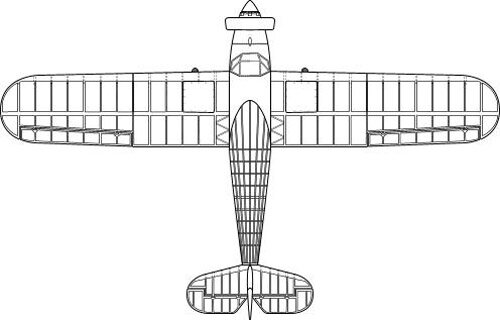 AIR-6L top.jpg29.1 KB · Views: 17
AIR-6L top.jpg29.1 KB · Views: 17 -
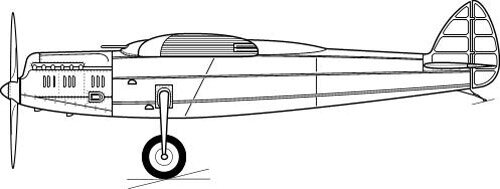 project N°3 left.jpg23.1 KB · Views: 10
project N°3 left.jpg23.1 KB · Views: 10 -
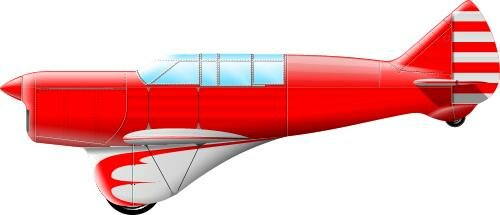 Project N°2 color.jpg12.5 KB · Views: 8
Project N°2 color.jpg12.5 KB · Views: 8 -
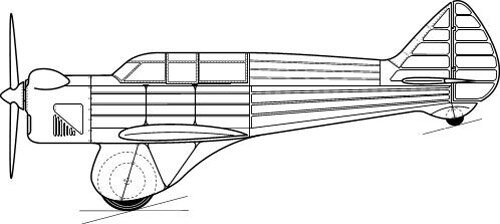 Project N°1 left.jpg28.3 KB · Views: 6
Project N°1 left.jpg28.3 KB · Views: 6 -
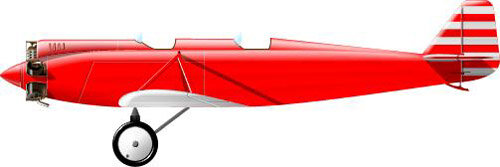 Samolyet N°2 color.jpg22.1 KB · Views: 7
Samolyet N°2 color.jpg22.1 KB · Views: 7 -
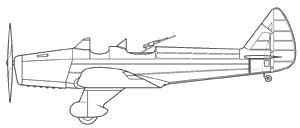 ut-23.jpg7 KB · Views: 10
ut-23.jpg7 KB · Views: 10 -
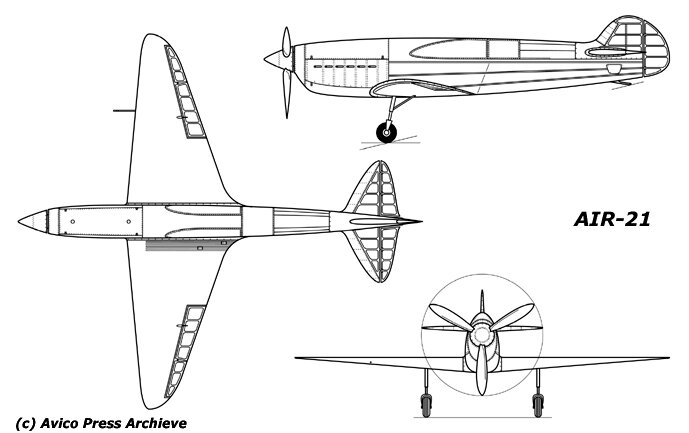 Air-21 project.jpg81.7 KB · Views: 10
Air-21 project.jpg81.7 KB · Views: 10 -
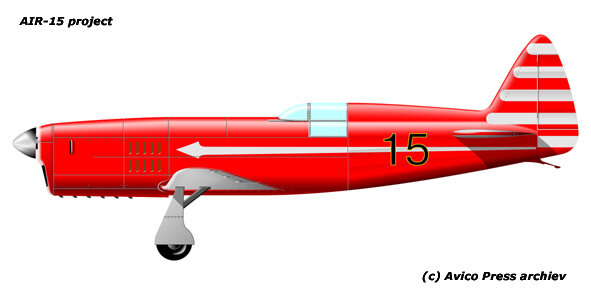 AIR-15.jpg66.8 KB · Views: 13
AIR-15.jpg66.8 KB · Views: 13 -
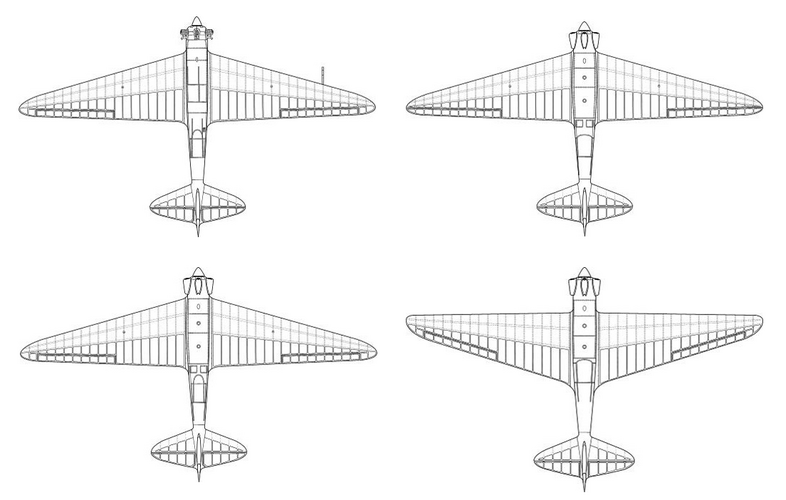 AIR-12 evolution.png274.6 KB · Views: 9
AIR-12 evolution.png274.6 KB · Views: 9 -
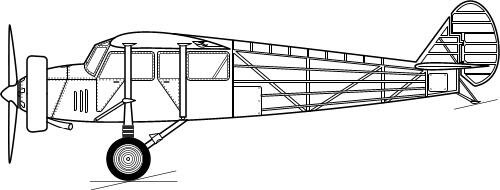 AIR-6P left.jpg17.3 KB · Views: 9
AIR-6P left.jpg17.3 KB · Views: 9 -
 AIR-6P front.jpg11.7 KB · Views: 10
AIR-6P front.jpg11.7 KB · Views: 10
- Joined
- 26 May 2006
- Messages
- 34,079
- Reaction score
- 14,600
Amazing and great work as usual my dear Apphenia,
and I can add;
AIR-1 it was built as replica in 1977
AIR-2S it was also built as replica in 2001
AIR-3 was a variant,fitted with M-23 engine (the original powered by one
60 hp Walter NZ engine)
PS (AIR-4) was a transport version of AIR-4,as experimental aircraft
AIR-5 was powered by one Wright J-4A engine
AIR-5 was a product version,powered by one M-48 engine
P (AIR-6 first use) was a six-seat light transport project,powered by one 300 hp
M-26 radial engine,it was appeared in 4 different versions,1930
AIR-6 Production versions had some minor changes
AIR-6A Floats was a seaplane version,equipped with floats
AIR-6 Arctic version was to use in high north,fitted with skis or floats
AIR-6 Ambulance was an ambulance version,with a triangular door on
the port side of the fuselage for loading the stretcher
AIR-7 was the AIR-7 repaired,undergoing some modification in the process
AIR-10 (II) Floats was a seaplane version
AIR-14 UT-1,with many variants
UT-1 with M-11Ye
UT-1 with M-11F
UT-1 with lengthened engine mounted
UT-1 with floats
UT-1 as armed fighter-trainer
UT-1 with M-12
UT-1B wartime attack version
UT-1 as armed version by Volkov
UT-1 as armed version by Moskatov
UT-1 with two BK machine guns,project
UT-1 with Renault Bengali A or MV-4 engine
UT-1 as experimental aircraft
UT-1 as aerodynamics testbed
UT-1 with retractable undercarriage and enclosed cockpit
UT-1 with automatic flaps
UT-1 with GAZ-Avia engine
UT-1 with experimental different propellers
UT-1 as a remote-controlled target drone conversion
and I can add;
AIR-1 it was built as replica in 1977
AIR-2S it was also built as replica in 2001
AIR-3 was a variant,fitted with M-23 engine (the original powered by one
60 hp Walter NZ engine)
PS (AIR-4) was a transport version of AIR-4,as experimental aircraft
AIR-5 was powered by one Wright J-4A engine
AIR-5 was a product version,powered by one M-48 engine
P (AIR-6 first use) was a six-seat light transport project,powered by one 300 hp
M-26 radial engine,it was appeared in 4 different versions,1930
AIR-6 Production versions had some minor changes
AIR-6A Floats was a seaplane version,equipped with floats
AIR-6 Arctic version was to use in high north,fitted with skis or floats
AIR-6 Ambulance was an ambulance version,with a triangular door on
the port side of the fuselage for loading the stretcher
AIR-7 was the AIR-7 repaired,undergoing some modification in the process
AIR-10 (II) Floats was a seaplane version
AIR-14 UT-1,with many variants
UT-1 with M-11Ye
UT-1 with M-11F
UT-1 with lengthened engine mounted
UT-1 with floats
UT-1 as armed fighter-trainer
UT-1 with M-12
UT-1B wartime attack version
UT-1 as armed version by Volkov
UT-1 as armed version by Moskatov
UT-1 with two BK machine guns,project
UT-1 with Renault Bengali A or MV-4 engine
UT-1 as experimental aircraft
UT-1 as aerodynamics testbed
UT-1 with retractable undercarriage and enclosed cockpit
UT-1 with automatic flaps
UT-1 with GAZ-Avia engine
UT-1 with experimental different propellers
UT-1 as a remote-controlled target drone conversion
- Joined
- 26 May 2006
- Messages
- 34,079
- Reaction score
- 14,600
Dear Apophenia!
Check out the gliders section of this website. AIR-10 and AIR-10 bis are also AIR-20.
airfield.narod.ru
LT - light tourist, although it is more correct (light multipurpose)
You can also consult with Mr. K. G. Udalov
Check out the gliders section of this website. AIR-10 and AIR-10 bis are also AIR-20.
airfield.narod.ru
LT - light tourist, although it is more correct (light multipurpose)
You can also consult with Mr. K. G. Udalov
Last edited:
- Joined
- 25 July 2007
- Messages
- 4,261
- Reaction score
- 4,011
I-29 (BB-22IS)
Single-seat fighter based on the BB-22 . The plane was equipped with M-105 engines. The armament consisted of two ShVAK ventral cannons (each with 300 rounds of ammunition).
Built at plant No. 115 in one copy. The first flight took place in December 1940. Factory tests took place in the spring of 1941. It was not mass-produced.
No direct mention of any 'Ya-29', however.
- Joined
- 25 July 2007
- Messages
- 4,261
- Reaction score
- 4,011
... and I can add; ...
Thanks hesham. Many of those have now been added.
AIR-3 variants: I suppose that those were realised as the AIR-4 (except that the M-23 and NZ-60 order was reversed).
PS: I regarded the PS as a Kozlov PoC modification. However, having included the AIR-4MK, I suppose that Prof. Kozlov's PS could be added ... so I did
On your 18 x UT-1 variants ... I was intentionally avoiding VVS types in favour of 'internal' designations.
- Joined
- 25 July 2007
- Messages
- 4,261
- Reaction score
- 4,011
...
A few remarks/questions:
- Are you suggesting that the "AIR-2S" designation was used twice? Or was the seaplane variant just one of the Siemens-powered aircraft?
- Why the two AIR-4 mods under AIR-8 ?
- Thanks for confirming that BPB-22 was the I-31 (I always had a hunch it was, but had no confirmation).
- "Ya-33" is a first for me, I don't know if it's a real one.
- The AVF-34 is also new to me.
- Are you 100% positive that the Ya- prefix was used past Ya-26? I have the following designs just as I- for "Izdeliye" (product).
Cheers Stargazer! Many of your additions and corrections have now be added to my list in reply #4. First a few remarks ...
AIR-6L & AIR-6P: These two sub-types were obviously from that unbuild first AIR-6 series. I'm wondering if 'P' was first applied to a proposed passenger version of what I'm calling 'AIR-6 (I)' whereas, as you say, 'P-5' actually applies to the built VVA-5/'AIR-6 (II)'? And, following from that ... then what does the 'L' suffix in AIR-6L refer to?
AIR-20: I was fudging. It is not clear to me whether the Ya-20 was directly related to the similar AIR-18 ... so I listed the 'AIR-20'/Ya-20 as a development of the original AIR-10.
UT-23: Thanks, I was confused by this armed Ya-20 derivative. I was going to list it as 'Ya-23 (I)' but have decided to omit my rather dodgy 'Ya' listings for now.
Now, answers to the above follow (in your order):
AIR-2s/AIR-2S: I am quite unclear as to whether there were two separate designations. I've seen the Siemens-Halske powered landplane listed as AIR-2s (with an usual lower case 's') and the seaplane as AIR-2S (capital 'S'). That seemed odd but I did wonder whether a distinction might have been made between 's' for Siemens versus 'S' for Vadim Shavrov (designer/maker of the floats).
Then again, the simplest explanation of s-versus-S would be that someone forgot to hit the 'shift' bar. If that is the case, then we must assume that all Siemens-Halske engined AIR-2 got the S suffix ... and either there was no sub-type suffix for the floatplane or we just haven't found it yet.
"Why the two AIR-4 mods under AIR-8 ?": Typos - now corrected - thanks for noting them.
"'Ya-33' is a first for me, I don't know if it's a real one.": Nor am I. That designation was asserted by hesham but without providing any reference.
"Are you 100% positive that the Ya- prefix was used past Ya-26?": No, I have no certainties on the 'Ya' list at all!
By accident, I omitted my intended qualifying note on 'Ya' designations. (Apologies, for that.) There are any number of sources which assume at 'I-xx' or 'No. xx' or 'whatever xx' automatically translated into 'Ya-xx'. This makes it all but impossible to verify the voracity of such claims.
My solution is to delete my 'Ya' listing for now. Since underlying claims may be largely unsound, I fear that my 'Ya' listing will just be perpetuating those often false assumptions and end up perpetuating myths.
- Joined
- 26 May 2006
- Messages
- 34,079
- Reaction score
- 14,600
My dear Apophenia,
the AIR-3 with M-23 is not related to the later AIR-4.
Also the PS (AIR-4) Is not related to AIR-4MK E-31.
For more additions,
AIR-15 First use, it was a developed version of UT-1 as UT-1E,possibly
wrong designation
AIR-15 Project was powered by one 230 hp MM-1 engine
AIR-18 Floats was a version ,fitted with floats as seaplane
- Joined
- 25 July 2007
- Messages
- 4,261
- Reaction score
- 4,011
...
the AIR-3 with M-23 is not related to the later AIR-4.
Also the PS (AIR-4) Is not related to AIR-4MK E-31.
AIR-3: You are saying that the sole AIR-3 which was modified into the M-23 powered AIR-4 has no relation to a "AIR-3 with M-23". Can you clarify that statement? Is there a source?
PS: I never said that it was related to the AIR-4MK.
Last edited:
- Joined
- 25 July 2007
- Messages
- 4,261
- Reaction score
- 4,011
...
AIR-15 First use, it was a developed version of UT-1 as UT-1E,possibly wrong designation
AIR-15 Project was powered by one 230 hp MM-1 engine
AIR-18 Floats was a version ,fitted with floats as seaplane
Thanks for the Bessonov engine ID.
I don't understand the distinction being made for your "AIR-15 First use". I've posited the 1938 AIR-15 as being an AIR-14 (UT-1) variant. Are you suggesting that there was another, earlier AIR-14/UT-1 variant also designated as AIR-15?
Any internal Yakovlev designation for that AIR-18 on floats?
- Joined
- 26 May 2006
- Messages
- 34,079
- Reaction score
- 14,600
AIR-3: You are saying that the sole AIR-3 which was modified into the M-23 powered AIR-4 has no relation to a "AIR-3 with M-23". Can you clarify that statement? Is there a source?
The source is the OKB Yakovlev,A History of the Design Bureau and His
Aircraft.
Attachments
- Joined
- 26 May 2006
- Messages
- 34,079
- Reaction score
- 14,600
Later I will talk about Yak series,we can say,
Yak 1,1/II,2,3,3/II,4,5,5/II,6,7,7-37,7 Liaison,8,9,9Jet,9V,10,11,12,12/II,
13,14,14/II,15,16,17,18,18T,19,219RD-1,19RD-1/II,19 Jet I,19 Jet II,20,
21,22,23,24,24P,24R,24T,25,25/II,26,27,27/II,28,28/II,28-64,29,30,30/II,
30 STOL,31,32,32/II,32 HEL,33,3435,35/II,36,36/II,36/III,36M,37 ?,38,39,
40,40/II,40/III,40 VTOL,40MISTEL,41,41/II,41/III,41/IV,42,43,44,45,46,47,
48,49,5050/II,50/III,50/IV,51,52,53,54,55,56,57,58,60,60 HEL,70,77,80 ?
90 ?,100,104,104/II,105,112,118,120,121,122,123,124,125,129,130,131,
132,133,135,135/II,140,141,142,152,200,201,210,220,242,315 &1000
Yak 1,1/II,2,3,3/II,4,5,5/II,6,7,7-37,7 Liaison,8,9,9Jet,9V,10,11,12,12/II,
13,14,14/II,15,16,17,18,18T,19,219RD-1,19RD-1/II,19 Jet I,19 Jet II,20,
21,22,23,24,24P,24R,24T,25,25/II,26,27,27/II,28,28/II,28-64,29,30,30/II,
30 STOL,31,32,32/II,32 HEL,33,3435,35/II,36,36/II,36/III,36M,37 ?,38,39,
40,40/II,40/III,40 VTOL,40MISTEL,41,41/II,41/III,41/IV,42,43,44,45,46,47,
48,49,5050/II,50/III,50/IV,51,52,53,54,55,56,57,58,60,60 HEL,70,77,80 ?
90 ?,100,104,104/II,105,112,118,120,121,122,123,124,125,129,130,131,
132,133,135,135/II,140,141,142,152,200,201,210,220,242,315 &1000
Last edited:
- Joined
- 26 May 2006
- Messages
- 34,079
- Reaction score
- 14,600
Later I will talk about Yak series,we can say,
Yak 1,1/II,2,3,3/II,4,5,5/II,6,7,7-37,7 Liaison,8,9,9Jet,9V,10,11,12,12/II,
13,14,14/II,15,16,17,18,18T,19,219RD-1,19RD-1/II,19 Jet I,19 Jet II,20,
21,22,23,24,24P,24R,24T,25,25/II,26,27,27/II,28,28/II,28-64,29,30,30/II,
30 STOL,31,32,32/II,32 HEL,33,3435,35/II,36,36/II,36/III,36M,37 ?,38,39,
40,40/II,40/III,40 VTOL,40MISTEL,41,41/II,41/III,41/IV,42,43,44,45,46,47,
48,49,5050/II,50/III,50/IV,51,52,53,54,55,56,57,58,60,60 HEL,70,77,80 ?
90 ?,100,104,104/II,105,112,118,120,121,122,123,124,125,129,130,131,
132,133,135,135/II,140,141,142,152,200,201,210,220,242,315 &1000
I forget to add Yak-13/II and Yak-140/II.
AIR-3 with dv. M-23 has nothing to do with AIR-4. AIR-4 was built with dv. Walter and much later the dv. M-23 was installed.The source is this 1994 book, page 38-43.AIR-3: You are saying that the sole AIR-3 which was modified into the M-23 powered AIR-4 has no relation to a "AIR-3 with M-23". Can you clarify that statement? Is there a source?
PS: I never said that it was related to the AIR-4MK.
Attachments
- Joined
- 25 July 2007
- Messages
- 4,261
- Reaction score
- 4,011
AIR-3 with dv. M-23 has nothing to do with AIR-4. AIR-4 was built with dv. Walter and much later the dv. M-23 was installed.The source is this 1994 book, page 38-43.
Thanks, igor-mich. Just to clarify, are you saying that the sole AIR-3 airframe (СССР-310) was re-engined with an M-23 but was never rebuilt as the AIR-4?
If so, how did the unrelated AIR-4 differ from the AIR-3? (I mean by way of general layout, etc.)
If not, was there more than one AIR-3 built?[/U]
Similar threads
-
DoD Temporary Designations for Soviet / Chinese Aircraft based on airfield
- Started by overscan (PaulMM)
- Replies: 51
-
-
-
-

